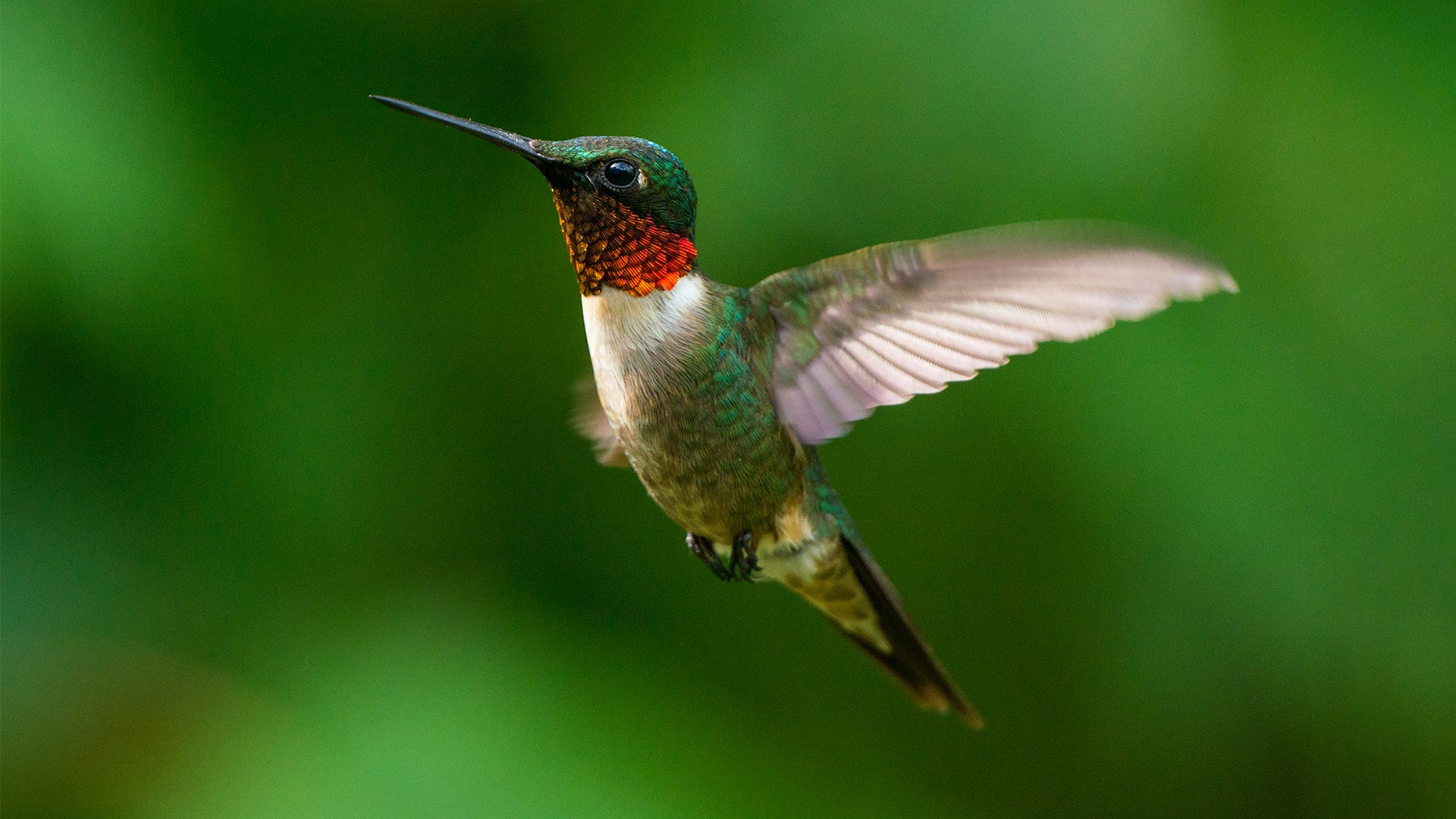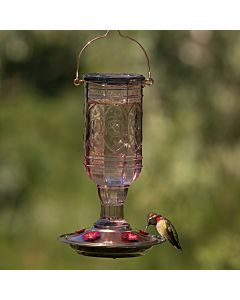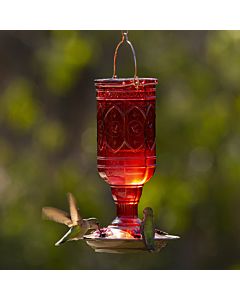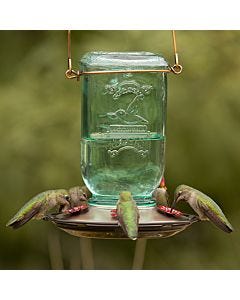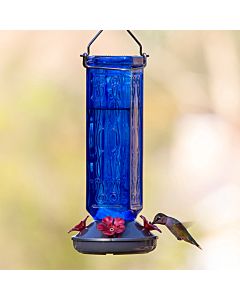By now, hummingbird migration is in full swing. To the delight of hummingbird enthusiasts everywhere, Ruby-throated hummingbirds are already at feeders in many gulf coast cities! If you live along their migration route, you may need to get your feeders prepped and filled to the brim with Perky-Pet®nectar a bit earlier than you did last year at this time.
Whether you’ve been getting hummingbird visitors for years or you’re new to participating in the hummingbird migration extravaganza, we’re here to tell you all you need to know about this magnificent journey and how you can help along the way!
PREPARE FOR THEIR ARRIVAL TODAY
About Ruby-throated Hummingbirds
Ruby-throated Hummingbirds may be small in size, but they are big in iridescent colors. With emerald green backs and crowns, white or gray bellies and bright red throat patches, you will know you’re gazing upon a male Ruby-throat when you see one. Females have similar green and white colors; however, they don’t have the ruby colored throats that the males do. Each year, Ruby-throated Hummingbirds, along with a few other hummingbird species, take part in a long journey known as migration.
Ruby-throated Hummingbird Migration Route
Ruby-throated Hummingbirds breed in North America during the summer months, but prefer to spend their winters in much warmer climates. The pursuit for warmer weather creates a long and sometimes daunting journey to return to their breeding grounds each year. By knowing when the Ruby-throated Hummingbirds will be in your area, you can get your hummingbird feeder ready in plenty of time to take part in their miraculous migration.
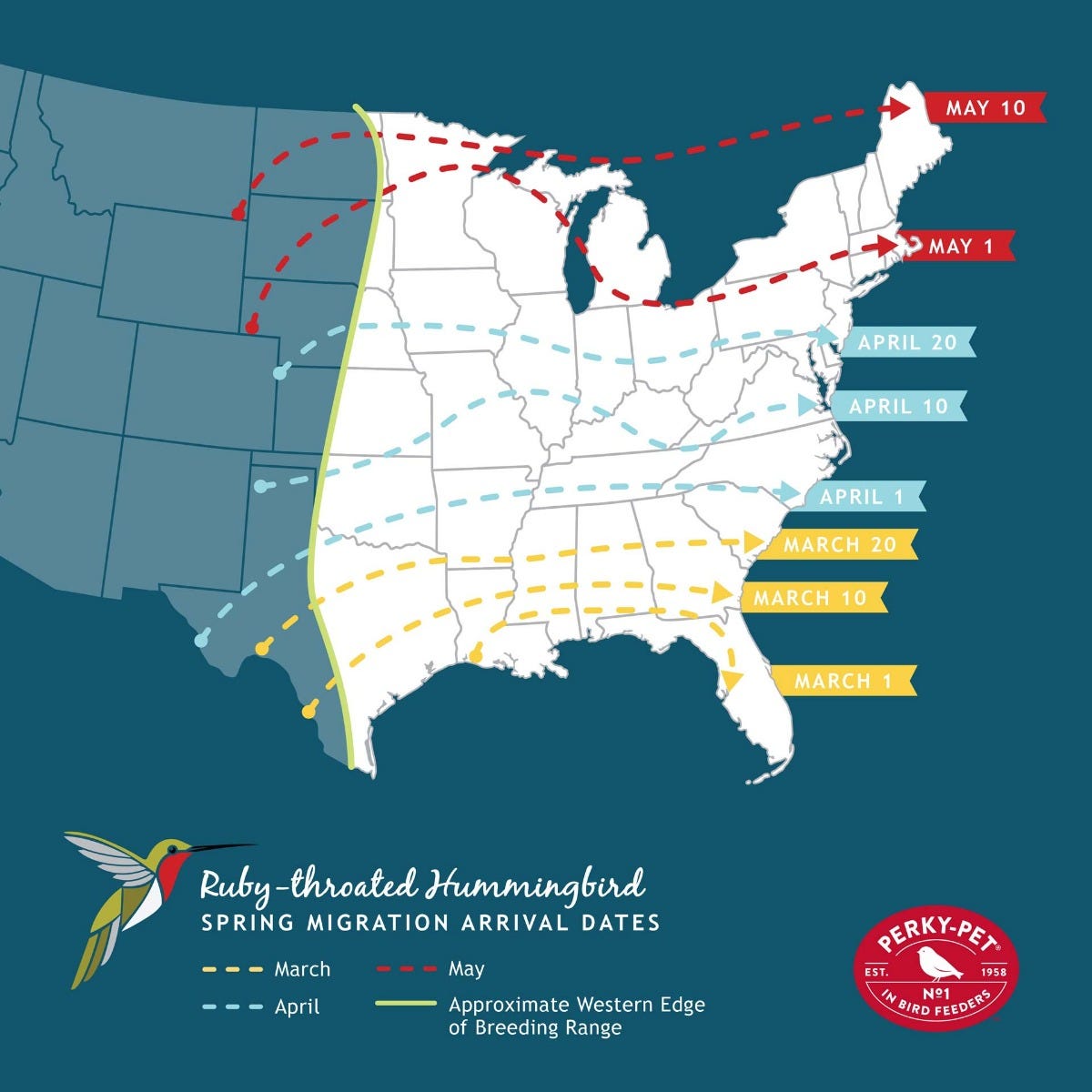
For those living in Eastern North America, the Ruby-throated Hummingbird is the only breeding hummingbird around. If you’ve spotted a hummingbird at your feeders in this part of the country, then chances are that it’s a Ruby-throat. You can see these birds as far west as Texas and North Dakota, and as far north as parts of central and eastern Canada.
During the cold winter months, Ruby-throated Hummingbirds spend their time in Central America and southern Mexico. Then, as the weather begins to turn warm, they will start to make their northern trip up to the United States. This can be a grueling journey, as many of them choose to fly over the Gulf of Mexico. This flight alone can take 18-22 hours of non-stop flight before reaching land on the other side of the gulf!
When Do Ruby-throated Hummingbirds Migrate?
Unlike other bird species, hummingbirds prefer to migrate as solo flyers rather than in large flocks, so it’s really up to each individual hummingbird’s instincts as to when the journey needs to begin. Several factors will determine when a hummingbird begins to migrate:
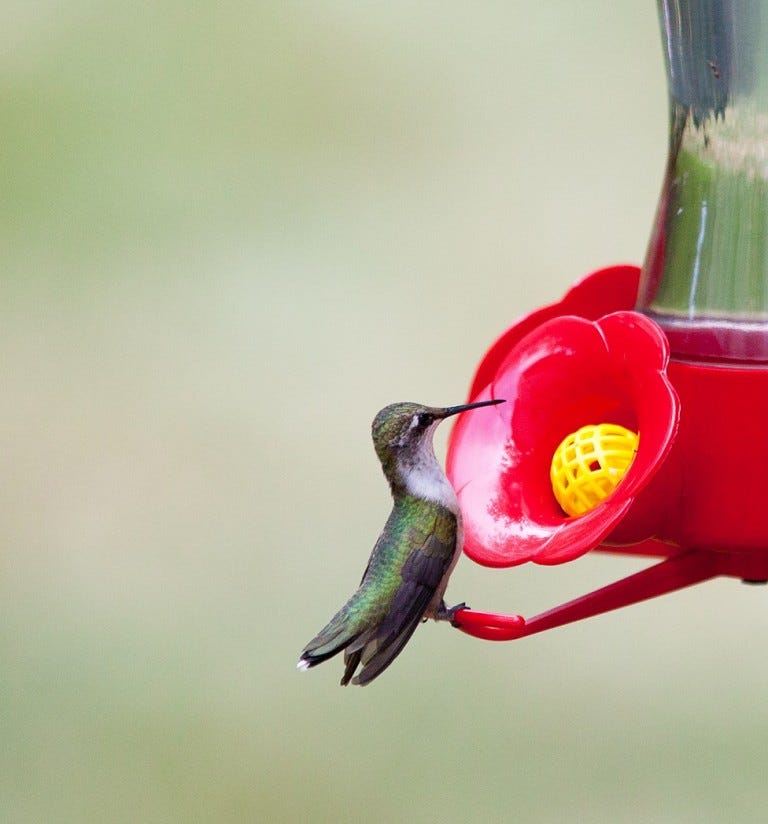
- Sunlight. Probably the biggest determining factor for a Ruby-throated Hummingbird to begin the migration trek is the angle of the sun. Hummingbirds fly during the day and rest at night. As daylight hours increase, food sources will be available for longer periods, and therefore, the amount of daily flying time will increase as well.
- Food. Energy and nutrition are key factors to surviving this long journey. Before the trip, hummingbirds will need to bulk up so they have enough energy to make the arduous flight. Some of them will even double their weight. The disappearance of certain food sources from their wintering grounds and the appearance of other foods along the way will help signal to a hummingbird that it may soon be time make the move.
- Gender. Male Ruby-throated Hummingbirds will leave for their breeding destination a few days earlier than females. The males need to establish their territory first so they can then court the females who follow a few days later.
Ruby-throated Hummingbirds will typically begin their northern migration in late February to early March. By mid to late March, they will begin reaching the southern tips of many Gulf Coast states such as Texas and Louisiana. From there, they will continue their journey north through the United States, reaching Pennsylvania and Illinois around late April or early May. Hummingbirds will usually reach their final breeding destinations sometime around the end of May. Here, they will spend their summer breeding, raising their young and fattening up for their journey south in the fall.
Ruby-throated Hummingbirds usually start their fall migration in late August or September. From here, they retrace their previous northern routes, and make their exhausting journey back down to Central America.
How to Help During Migration
The first Ruby-throats of the season have already begun to reach land in the southern United States. That means it’s time to begin prepping your yard so you’re ready when they finally reach your area. Look at hummingbird migration maps of years past to help determine an approximate time when Ruby-throated Hummingbirds will arrive in your region.
Here are a few additional steps you can take to attract hummingbirds during migration and assure they have what they need when traveling:
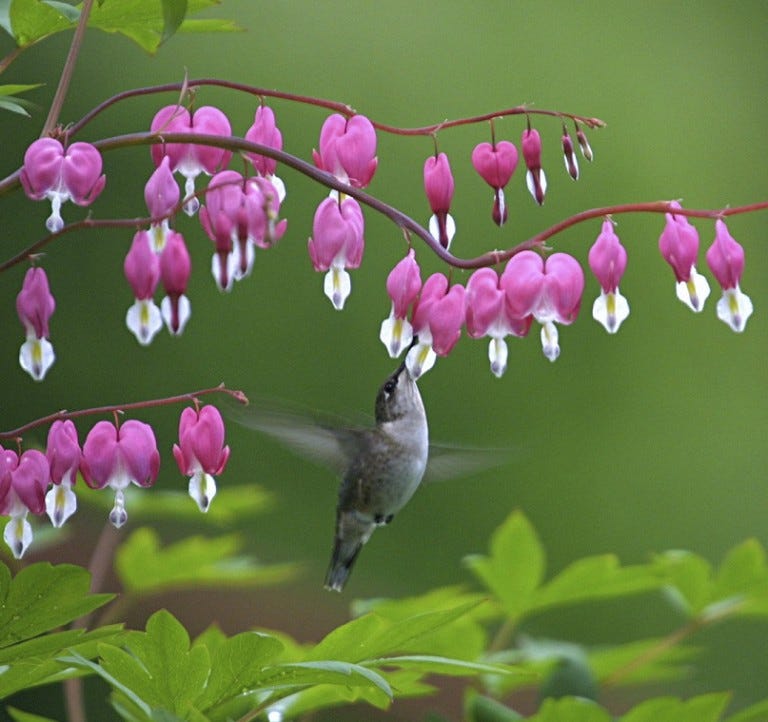
- Hang Feeders. Begin setting out your feeders a few weeks before hummingbird sightings typically begin in your area. This will give any early arrivals a food source if needed, as some birds may be arriving before spring flowers are in bloom. In addition, make sure your hummingbird feeders are full and clean. Keep them out of direct sunlight to prevent hummingbird food from spoiling. Try to clean feeders a few times a week to remove any debris or mold that could contaminate the nectar. The farther south you live, the longer you should keep your feeders up in the fall to ensure that stragglers have plenty of food during their southern migration.
- Plant Flowers. Hummingbirds love nectar-producing flowers such as bee balm and honeysuckle. Be sure to plant early- and late-blooming flowers to give hummingbirds a selection all season long. Providing a combination of feeders and nectar-producing flowers is the best way to attract hummingbirds to your yard.
- Provide Nesting Materials. Unlike some species of birds that prefer houses and nest boxes, hummingbirds build their own nests. They will not use birdhouses to lay their eggs and raise their young. Instead, provide them with nesting materials in your yard such as cotton, moss, feathers and spider silk so they can build nests on your property.
- Maintain Shelter. Hummingbirds are very active during the day, but they rest during the night hours. Provide them with safe shelter such as trees and shrubs to protect them from wind, rain and predators.
Ruby-throated Hummingbirds are attracted to vibrant colors. As a hummingbird is flying by, it will spot brightly colored flowers and feeders and stop by for a drink. Hummingbirds have a fantastic memory. Once they find nectar, insects, or shelter in your yard, they will remember your location and often return each year on their journey.
Returning South
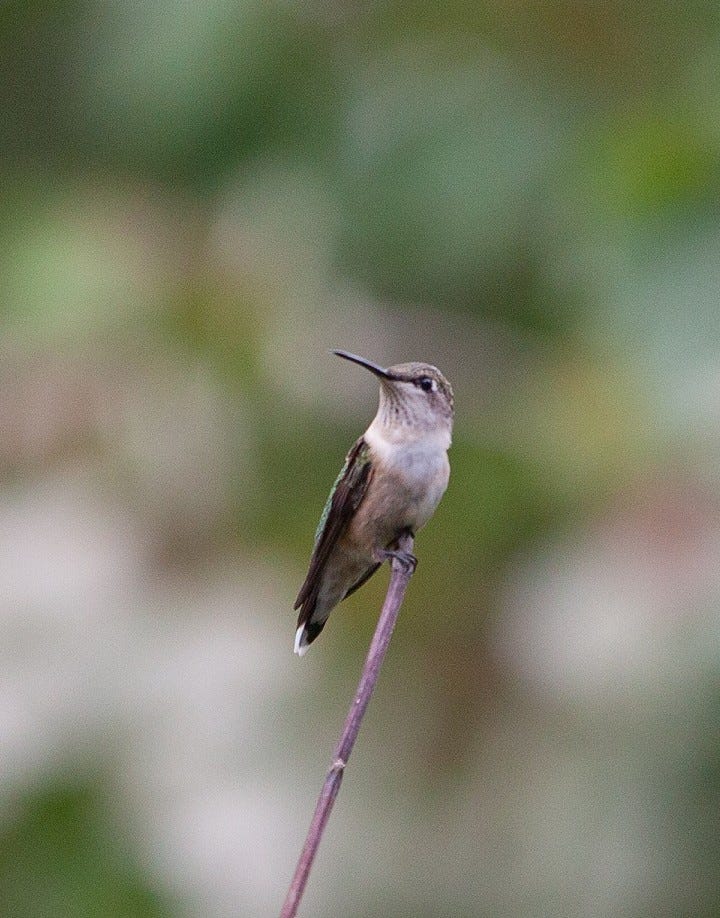
The approach of cool, fall weather signals to migratory hummingbirds that their time in the North has come to an end. Juvenile and mature Ruby-throats will begin to fatten up once again, storing energy for another difficult flight. Ruby-throated Hummingbirds will follow almost the exact route they took north to their breeding grounds just a few short months ago. It is critical that you try to keep your feeders up through fall to ensure that any late-moving hummers have a food source for their fall migration.
Some Ruby-throats will begin their trek south as early as July, but most will wait until August or September to begin their flight. You may see more hummingbirds stopping by your feeders during fall migration than during spring migration because they’re returning with the juvenile hummers born during the summer. Keeping your feeders full and available throughout the fall will show the new juveniles that your yard is a hot spot for a nutritious meal and help ensure that they will return to your yard during their spring trip back up north!
Discover More About Ruby-Throated Hummingbirds
Be sure to check out our Species Spotlight and Species Library for more in-depth information about these feisty birds.
On your next visit to our Facebook page, share your pictures and stories of hummingbird visitors with the Perky-Pet® Community. Also, subscribe to our e-newsletter to receive notifications about other great articles, as well as new products and great deals on bird feeding accessories.





